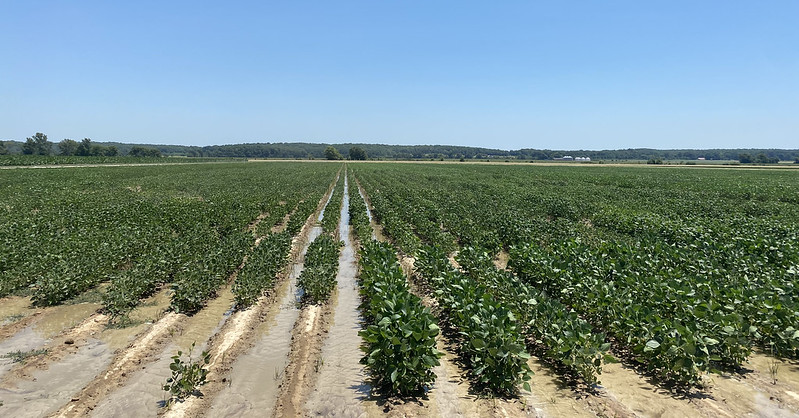As floodwaters recede, Arkansas soybean planting moves ahead
May 5, 2025
By Ryan McGeeney
U of A System Division of Agriculture
Fast Facts:
- Arkansas growers on track to plant 3 million soybean acres
- Rain delays likely to spread out planting, harvest
(376 words)
(Newsrooms: Download file art, April flood photos)
LITTLE ROCK — As flood waters have receded over the past three weeks, Arkansas growers have made successful inroads toward timely planting of soybeans and other crops.
Major storm systems and flooding across Arkansas in early April left the 2025 planting season an open question for many in the agricultural industry. With an estimated $78.9 million in crop losses, growers were faced with the likely total loss of wheat, as well as any early-planted corn or soybeans.
According to the U.S. Department of Agriculture, 45 percent of the state’s planned 3 million soybean acres had been planted as of April 27, putting growers well ahead of the five-year average of 31 percent planted for this point in the season.
Jeremy Ross, extension soybean agronomist for the University of Arkansas System Division of Agriculture, said most of the state’s soybean acreage will likely recover from April’s damage.
“When you get away from the flooding closer to major rivers, farmers are planting fields that are dry,” Ross said April 28. “There was quite a bit of field activity last week in some areas, but some received rain last weekend and more today.”
In 2024, harvest for many Arkansas crops, from corn to soybeans to rice, came to fruition in a tight time window, causing bottlenecks at buying points, sometimes overwhelming barge and storage capacity. Ross said the timing of the 2025 harvest is likely to be more dispersed.
“This is going to be one of those years where we will have gaps in the planting, which is not a bad thing when it comes to spreading out the harvest,” he said. “I was still walking fields the first of this week assessing plant stands, and we are keeping a majority of the planted fields I’ve walked. Some spot planting and lower ends of fields, where water stood for several days, will need to be replanted.”
In its April 28 Crop Progress report for Arkansas, the National Agricultural Statistics Service said farmers had 45 percent of their soybeans planted, with 24 percent emerged.
Arkansas corn was 80 percent planted and 58 percent emerged, while cotton was 6 percent planted and 1 percent emerged. Rice was 68 percent planted and 40 percent emerged. Peanuts were 5 percent planted, according to NASS.
To learn about extension programs in Arkansas, contact your local Cooperative Extension Service agent or visit www.uaex.uada.edu. Follow us on X and Instagram at @AR_Extension. To learn more about Division of Agriculture research, visit the Arkansas Agricultural Experiment Station website: https://aaes.uada.edu/. Follow on X at @ArkAgResearch. To learn more about the Division of Agriculture, visit https://uada.edu/. Follow us on X at @AgInArk.
About the Division of Agriculture
The University of Arkansas System Division of Agriculture’s mission is to strengthen agriculture, communities, and families by connecting trusted research to the adoption of best practices. Through the Agricultural Experiment Station and the Cooperative Extension Service, the Division of Agriculture conducts research and extension work within the nation’s historic land grant education system.
The Division of Agriculture is one of 20 entities within the University of Arkansas System. It has offices in all 75 counties in Arkansas and faculty on three campuses.
Pursuant to 7 CFR § 15.3, the University of Arkansas System Division of Agriculture offers all its Extension and Research programs and services (including employment) without regard to race, color, sex, national origin, religion, age, disability, marital or veteran status, genetic information, sexual preference, pregnancy or any other legally protected status, and is an equal opportunity institution.
# # #
Media Contact:
Ryan McGeeney
rmcgeeney@uada.edu
@Ryan_McG44
501-671-2120
